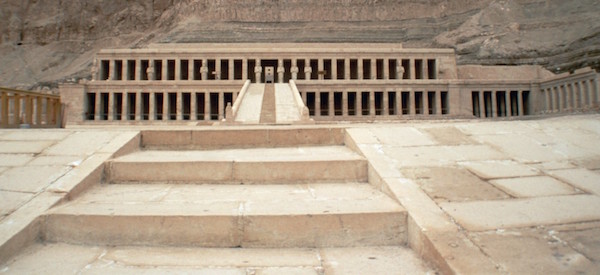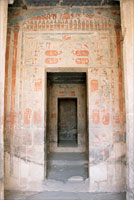The Mortuary Temple of Hatshepsut is one of the most beautiful of all of the temples of Ancient Egypt. It is located at Deir el-Bahri (“the Northern Monastery”), at the head of the valley beneath the peak of the mountain (and natural pyramid) “Dehent” (now known by its Arabic name, el-Qurn – “The Horn”). Hatshepsut’s temple was named “Djeser-djeseru” (“holy of holies”).
It sits directly against the rock which forms a natural amphitheatre, so that the temple seems to grow from the living rock. The design of the temple echoes that of its neighbour, the Mortuary Temple of Montuhotep. There is also a mortuary temple dedicated to Thuthmosis III and a number of Ptolemaic burials in the vicinity. Apparently, there used to be a mud brick temple dedicated to Amenhotep I and Queen Ahmose Nefertari, but it was destroyed to make way for Hatshepsut’s temple.

Hatshepsut is an intriguing character. She initially ruled as regent for her step-son Thuthmosis III but promoted herself to the role of pharaoh instead of passing power to him when he came of age.
Her temple is one of the most striking monuments in Ancient Egypt even in its semi-ruined state. It was designed by Senenmut (who according to some ancient and modern commentators was her lover) as a “garden for her father” (Amun) and exotic trees and shrubs from Punt (possibly Somalia) were planted in the lower courtyard. However, after her death, Thuthmosis III and Akhenaten both intentionally damaged the monument. The former directed his attacks at Hatshepsut herself, either replacing her image with his own or simply obliterating references to her, the latter damaged her temple because of the frequent references to the god Amun.
She was omitted from the Kings lists of Ramesses II and Seti I, but Ramesses II and Merneptah both made additions to her temple. During the Ptolemaic Period the temple was repaired in places. Some repairs to the temple reveal that they apparently thought it was dedicated to Imhotep and Amenhotep son of Hap. Some time later, a Christian Monastery was built upon the ruins which covered much of the original temple.
Layout

- Entrance pylon
- First courtyard
- Ramp to level 2
- Second courtyard
- Senenmut’s tomb
- Ramp to level 3
- Punt colonnade
- Birth colonnade
- Hathor chapel
- Anubis chapel
- Third courtyard
- Royal cult chapel
- Solar cult chapel
- Amun’s Sanctuary
A one hundred and twenty foot wide causeway lined with trees and sphinx led from the valley to the entrance pylons. Unfortunately, no trace remains of the pylons and the two obelisk that would have stood in front of them are no longer in place. The temple was built on three levels with two wide ramps in a central position joining the levels together.

First Level
There was a garden in the first courtyard in which exotic trees and shrubs from Hathsepsut’s trading expedition to Punt were planted. There is now no evidence of this garden, but it must have been beautiful.
Behind the courtyard there was a colonnade with square pillars behind which there were many reliefs. Most of the depictions have been destroyed and none of those that remain feature Hatshepsut herself. The remaining decorations include Tuthmosis III dancing before the god Min, scenes depicting the marshes of Lower Egypt and the quarrying and transportation of two large obelisks down the Nile (these obelisks found a home in the temple of Karnak).
Second Level
A wide ramp runs from the centre of the first courtyard to the second level. Two statues of crouching lions flank the entrance to the ramp. Behind the wide terrace there is a colonnade with two rows of square columns on each side of the ramp leading to the third level.
Birth Colonnade
The birth colonnade is on the right hand side of the ramp to the third level. The decorations (which are repeated on the walls of the temple at Karnak) depict Hatshepsut’s divine birth. There has been significant damage caused both to the images of Hatshepsut (by Thuthmosis III) and to those of Amun (who was targeted by Akhenaten who sought to erase Amun and promote the Aten).

In the depictions, Amun appears with the unborn Hatshepsut and then with her mother (Queen Ahmose) in the form of Hatshepsut’s father (Thuthmosis I). Amun impregnates the queen with his divine breath then reveals his true nature and foretells that Hatshepsut will rule Egypt. Amun then visits Khnum to instruct him to create Hatshepsut’s body. A heavily pregnant Queen Ahmose is led to the birthing chamber by Heqet and Khnum where she is assisted by Meskhenet. In the final scenes, the newborn Hatshepsut and her Ka are suckled by twin Hathors while Seshat records her birth. Nekhbet watches over the proceedings, and the sky is festooned with gold stars on a blue background.
Punt Colonnade
The Punt colonnade is on the left hand side of the ramp to the third level. Hathsepsut’s expedition to Punt was obviously a great success and so she included a series of depictions of the trip to commemorate it. The reliefs show the expedition leaving Egypt in two boats and arriving in the exotic land of Punt. A small force establishes a camp to protect the traders, but the people of Punt welcome them in friendship and so no fighting is necessary. The chief and his wife greet the Egyptians saying …
“How have you arrived at this land unknown to the men of Egypt? Have you come down from the roads of the Heavens? Or have you navigated the sea of Ta-nuter? You must have followed the path of the sun. As for the King of Egypt, there is no road which is inaccessible to His Majesty; we live by the breath he grants to us.”
The Chief of Punt (named Parahu) and his wife (who is depicted as being extremely obese) are introduced to an Egyptian officer and then they visit their village in which the houses seem to sit on stilts. The Egyptians hold a feast for the people of Punt, who in turn given them incense, gold and precious gems. The Egyptians then return to their boats carrying all kinds of exotic and precious items described in the accompanying text as;

“all goodly fragrant woods, heaps of myrrh-resin, with fresh myrrh trees, with ebony and pure ivory, green gold of Amu, cinnamon-wood, khesyt-wood, ahmut-incense, senter-incense, eye makeup, apes, monkeys, dogs, skins of the southern panther, and with natives and their children”.
In the final scenes, the expedition returns home laden heavy with precious cargo including, thirty-one incense trees, gold, silver, lapis lazuli, malachite (and other precious stones), cattle, panthers, baboons, and other animals. Hatshepsut holds a procession to the Temple of Amun-Ra where sacrifices are held and the tributes are given to the temple.
Hathor Chapel
The area around Deir el Bahri was associated with the goddess Hathor as one of the main gods of the Theban necropolis. As one of the most powerful and respected female deities, Hathor may well have had a particular appeal for Hatshepsut. The Hathor chapel sits at the southern end of the second level colonnade. It originally had its own entrance ramp and a hypostyle hall with twelve beautiful Hathor-headed columns (like those found in Denderah). Unfortunately, only a few of the columns remain.

There are a number of depictions of Hatshepsut in this chapel; suckling on a bovine Hathor’s udder, dancing for Hathor, and seated between Hathor and Amun. Thuthmosis also makes an appearance, presenting a sacred oar to Hathor. The sanctuary of Hathor was cut into the living rock.
Anubis Chapel
At the northern end of the second level colonnade sits the chapel of Anubis. This small chapel has a hypostyle hall with twelve fluted columns and an astronomical ceiling. All of the depictions of Hatshepsut have been hacked out. For example, in one scene Anubis receives offerings from Hatshepsut but while the god himself is in good condition, poor Hatshepsut has been completely erased. The prime suspect for the damage is Thuthmosis III.
Unsurprisingly, most of the remaining depictions in the chapel are of Anubis, but Tuthmosis III makes an appearance worshipping Sokar and there are also representations of Nekhbet, Wadjet, Amun, Horemakhet (“Horus in the Horizon”) and Osiris.
Third Level

A wide ramp runs from the centre of the second courtyard to the third court. A statue of Horus as a falcon stands at each side of the entrance to the ramp. The upper level of Hatshepsut’s temple consists of a portico with two rows of columns facing the front behind which there is a central courtyard with small chambers off it.

The outermost columns were made up of huge Osiriform statues of Hatshepsut (of which only a few remain) and the inner row of octagonal columns. The first internal court also contained two rows of columns but most have been destroyed or removed. The walls on the left and right still bear the remnants of their decorations.
A central doorway leads back to a columned court with a chapel dedicated to the Royal cult on the left and a chapel dedicated to the solar cult on the right. Horemakhet, Anubis, Tuthmosis I and Queen Senseneb (possibly Thuthmosis I’s mother) are all depicted in the decorations of the Royal chapel.
In the solar chapel Hatshepsut, Raneferu (her daughter), and Tuthmosis III are all depicted kneeling and presenting offerings before the barque of Amun-Re.
This chapel suffered a great deal of damage during the Atenist period when many of the images of Amun were destroyed. All the images of Hatshepsut have been destroyed and replaced with images of Tuthmosis III. There was a limestone altar to Horemakhet in the solar chapel around which there are a number of depictions of gods which were defaced during the Atenist period. Horemakhet was not damaged, as he was considered to be a form of the Aten.
The Sanctuary of Amun
The sanctuary lies behind the courtyard. It was cut into the living rock and aligned so that it points towards Hatshepsut’s tomb in the Valley of the Kings. During the Ptolemaic Period the Sanctuary was re-built and rededicated to Imhotep (architect and vizier of Djoser credited with building his Step Pyramid) and Amenhotep son of Hap (the overseer of Amenhotep III).

Bibliography
- Bard, Kathryn (2008)An introduction to the Archaeology of Ancient Egypt
- Wilkinson, Richard H. (2000) The Complete Temples of Ancient Egypt
Copyright J Hill 2010